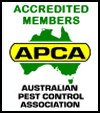Week 1 - Day 3 - Pesticide Control Equipment
ESSENTIAL READING BEFORE COMMENCEMENT OF COURSE:
Urban
Pest Management in Australia: 2004
Edition, UNSW Press, Sydney
by
J Gerozisis and P Hadlington
- Chapter 9 - Pages 75 to 84.
Chapter 9 – Insecticides – Formulations & Application - application equipment - equipment for surface treatments - sprayers - power sprayer - power and source pump - tank - hose and reel - spray gun - nozzle accessories - foaming unit for slab injections - compressed air sprayer - duster - bulb (hand puffer) type - mechanical rotary type - mechanical plunger type - electrical dusters - compressed gas type - equipment space spray treatments - thermal aerosol generators - cold aerosol generators - electrical, mister type - compressed, gas - equipment maintenance - other equipment and useful items - tools for improving access - basic tools - ladders - tools for cutting floor traps - drills and drill bits - inspection aids - torch - probe - adhesive tape - hand mirror - hand lens (x10) - borescopes - sound detection devices - moisture meters - the means to record findings - computer technology - plan of building/site - sample tubes and adhesive labels - items for cleanliness - drop sheet - brush and pan - plastic sheeting, plastic bags - cleaning rags - vacuum cleaner - warning signs
Protective
Equipment
To avoid poisoning, we need to protect ourselves when we
are handling and applying pesticides.
It is essential that the type of protective clothing being
worn properly covers the body and is fitted correctly.
Overalls
- Various types – cotton, waterproof, disposable
- Must be closed to the neck and the wrists
- Must be worn over the boots not tucked in
- Must be washed at the end of each day.
Gloves
- Must be waterproof, unlined
- Must be elbow length
Must be of approved Australian Standards materials
Respirators
- Three types – air-purifying, supplied-air, and
self-contained
- Can be half face or full face(dependant of chemicals
used)
- There are some disposable respirators
Hats
Disposable or waterproof (not made with absorbent material
eg. felt).
Face shields or Goggles:
- Clear plastic face cover
- Protects the face from splash particularly when handling
concentrate
- non-fogging types
- Must be worn when there is any chance of pesticide getting
into the eyes
Boots
- Must be impervious to chemicals
- Must not have bootlaces that could absorb chemical.
Code of Practice
The NSW Workcover authority has prepared a code of practice
as a guide for persons working in the pest control industry,
green keeping and other industries. It offers practical and
informative guidance on how to comply with the relevant legislation
relating to the use and storage of pesticides and herbicides.
A questionnaire has been developed so that you have a better
understanding of the safe use of pesticides whilst working
in the industry, this will be supplied to you during the
first few days of the course.
|
